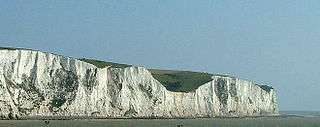
Albion (wherry)
Albion is a Norfolk wherry. Built in 1898, she served as a trading vessel and then as a lighter until being acquired by the Norfolk Wherry Trust for restoration and preservation in 1949. Since 1981 she has been moored at the Norfolk Wherry Trust wherry base at Womack Water near Ludham. She is listed on the register of National Historic Ships in the United Kingdom as part of the National Historic Fleet.
Appearance
Albion's construction is unique amongst Norfolk Wherries as she is carvel built (smooth hulled) whereas all others are clinker built. Apart from her hull construction, her general appearance follows that of a typical trading wherry with a forward counterbalanced mast of Oregon pine, a large cargo hold in the centre of the hull and crew quarters aft. She is steered from a small aft well by rudder and tiller.
Albion's registered tonnage is 22.78 and her length overall is 65 ft (20 m) with a 58 ft (18 m) hull. Her beam is 15 ft (4.6 m) and she draws 4 ft 6 in (1.37 m). Her mast is 42 feet (12.80 m) tall. Her sail area is 1,200 square feet (110 m2).

Albion
Albion (Ancient Greek: Ἀλβίων) is the oldest known name of the island of Great Britain. Today, it is still sometimes used poetically to refer to the island. The name for Scotland in the Celtic languages is related to Albion: Alba in Scottish Gaelic, Alba (genitive Alban, dative Albain) in Irish, Nalbin in Manx and Alban in Welsh, Cornish and Breton. These names were later Latinised as Albania and Anglicised as Albany, which were once alternative names for Scotland.
New Albion and Albionoria ("Albion of the North") were briefly suggested as names of Canada during the period of the Canadian Confederation. Captain Arthur Phillip originally named the Sydney Cove "New Albion", but for uncertain reasons the colony acquired the name "Sydney".
Etymology
The Brittonic name for the island, Hellenized as Albíōn (Ἀλβίων) and Latinized as Albio (genitive Albionis), derives from the Proto-Celtic nasal stem *Albi̯iū (oblique *Albiion-) and survived in Old Irish as Albu (genitive Albann). The name originally referred to Britain as a whole, but was later restricted to Caledonia (giving the modern Scottish Gaelic name for Scotland, Alba). The root *albiio- is also found in Gaulish and Galatian albio- ("world") and Welsh elfydd (elbid, "earth, world, land, country, district"). It may be related to other European and Mediterranean toponyms such as Alpes and Albania. It has two possible etymologies: either *albho-, a Proto-Indo-European root meaning "white" (perhaps in reference to the white southern shores of the island, though Celtic linguist Xavier Delamarre argued that it originally meant "the world above, the visible world", in opposition to "the world below", i.e., the underworld), or *alb-, Proto-Indo-European for "hill".
Albion (whaler)
The Albion was a 362-ton full rigged whaler built at Deptford, England. She was fitted with 10 guns and manned with a crew of 26. Owned by the firm Champion & Company, the vessel was sent to Australia waters in 1799 to conduct whaling and was chartered in 1803 to transport stores and cattle, to Risdon Cove on the River Derwent, Tasmania.
Under the command of Captain Eber Bunker, the Albion departed England in 1799 arriving in Port Jackson (Sydney) on 29 June 1799, with a cargo of salted pork after a voyage of 3 months and 15 days. Afterwards the Albion sailed to Taihiti at the request of Governor Philip Gidley King and spent the next two winters whaling off the Australian coast and the New Zealand coast. The Albion returned to England with a cargo of 155 barrels of whale oil.
Returning to Port Jackson on 6 July 1803, the Albion under command of Captain Eber Bunker went on a second whaling expedition along the Australian coast. Bunker discovered the Bunker Islands off the Queensland coast.
Albion (given name)
Albion is a given name, usually masculine, which may refer to:
Podcasts:

